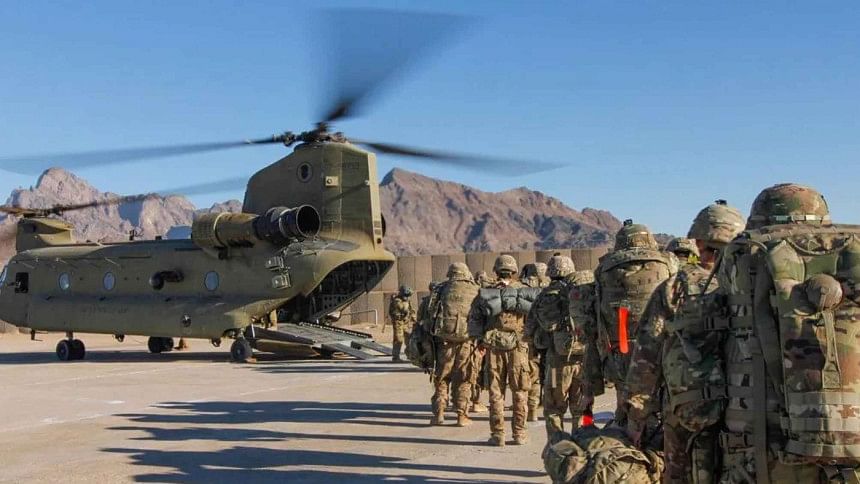After two decades of war, the US leaves an uncertain future for Afghans

June 2002. I was on my first visit to Kabul. People were trying to put together their lives with new hope. Kids seemed happy and curious. Some were walking to whatever remained of the schools. Some were playing on the streets, while others were curiously watching the foreigners.
Fast forward to 2021. On June 15, armed men gunned down five polio vaccinators and injured several others in Afghanistan's eastern Nangarhar province. On June 9, masked gunmen stormed into an office of HALO Trust, a charity engaged in mine clearing, and killed at least 10, injuring many others. On June 6, a roadside bomb killed 11 civilians traveling on a bus in western Afghanistan. Last month, Dasht-e-Barchi, a Hazara Shia Muslim neighbourhood in west Kabul, experienced a wave of Taliban violence—most of the 85 killed were school-going girls between the ages of 11 and 17. Such mindless violence has continued since the US signed the Doha Peace Agreement with the Taliban in February 2020. We have lost count of the casualties. Our senses have become numb.
What's more, the Taliban have warned neighbouring states against allowing any American military base in their territories. The Afghans, who, in the Taliban's view, had cooperated with the Americans—such as the interpreters—now fear for their safety after the withdrawal. In short, the Taliban are well on their way to returning as the definite victors while the American troops are slinking away.
If such is the outcome of two decades of bloody war, why did the US launch the offensive in 2001? What has caused the withdrawal? And who pays the price for its colossal misadventure?
Why the 2001 offensive?
The short answer is strategic positioning in the Eurasian "heartland" and Afghan mineral resources.
In 1904, English geographer Halford Mackinder, one of the founding fathers of geopolitics and geostrategy, published a paper titled "The Geographical Pivot of History" (republished in The Geographical Journal in December 2004). According to Mackinder, whoever controls the Eurasian continent or the "heartland" can exercise global dominance. This heartland comprises Central Asia and the Caspian basin—while Russia dominated it for many years, of late, Chinese influence is also increasing in this region. The other attraction for the US was Afghan minerals. Imperial Britain had conducted mineral assessments in Afghanistan till the 1919 Anglo-Afghan War. Subsequently, Russia (erstwhile Soviet Union) had continued such explorations until its departure in 1989. All these explorations suggested a lucrative reserve, including of several rare earth elements.
Thus, military strategy and the lure of minerals formed the background of America's ambitious 2001 offensive. Its official goal was to prevent terror groups from using Afghanistan as a safe haven. But in 2021, the number of such groups has risen from four to at least 20. Membership of Al Qaeda (including their offshoots) has increased from 400 to tens of thousands globally. The precarious security situation in the region has made mining almost impossible. Two decades of war have drained the US of trillions of dollars without making any discernible progress. Despite the high-sounding goals, the 2001 offensive and the massive firepower it deployed ended up as a dismal failure.
What went wrong?
Matthew Hoh, a senior fellow with the Center for International Policy and a Marine combat veteran, explained in a CNN opinion piece last month how the US misinterpreted the whole premise in Afghanistan. First, Washington's impression of the jihadists as the source of insurgency was utterly misplaced. Instead, most insurgents were only fighting foreign occupation forces. Second, several Afghan units resorted to atrocities, often against civilians, including women and children. By association, American troops were also implicated, strengthening the local population's resolve against their presence. Third, it was surprisingly easy for the Afghan insurgents to drain the American troops of their resources and patience. They lured them into frequent battles with minimal cost and effort. Eventually, the American policymakers realised that this was an endless war with no chances of winning it. Finally, Washington assumed that once Kabul came under control, the whole country would follow. It ignored the fact that Afghanistan is a complex mosaic of many tribes. Further, it interpreted Islam as a monolithic and extremist faith which, in reality, it is not. Many Muslims follow progressive and inclusive Islamic thoughts.
The combination of all these incorrect assumptions and impressions, mishandling of public sentiment, atrocities, and the unfavourable terrain led to a catastrophic failure of the American mission. Unfortunately, history is replete with similar fates of many invading foreign powers. We may euphemistically call it a withdrawal. But, in reality, Washington is only joining the long line of empires conceding abysmal ends in this inhospitable terrain.
Who pays for this misadventure?
Ordinary Afghan civilians caught up in the mindless conflicts between the different factions have already paid a steep price. A 2019 study by Brown University indicated that crossfire, improvised explosive devices (IEDs), assassinations, bombings, night raids of houses of suspected insurgents, and cluster bombs had killed civilians in disproportionate numbers. A rough estimate puts the total number of war deaths since 2001 at 157,000, of which more than 47,000 were civilians. In addition, around 2.7 million Afghans fled abroad and another four million were internally displaced in these two decades, according to a recent AP story. As the current trend of continued violence indicates, these numbers are likely to increase. Afghan women stand to lose everything they have achieved so far. In a Taliban-controlled regime, they will go back to restricted indoor lives, deprived of education, healthcare, and economic opportunities. A recent BBC documentary, "Killing Hope: Targeted Attacks in Afghanistan," shows how young professionals, often women, are being murdered.
What is the endgame?
Although officially withdrawing, the Americans will keep at least a thousand troops and some CIA officers on the ground to supervise Afghan National Army operations and gather intel. We are yet to see how it will pursue mining minerals or strategic objectives in the coming years. Aborting is not an option because too much is at stake in this far-flung, rugged, and hostile territory, historically known as the "graveyard of empires". Meanwhile, little kids like the ones I met on Kabul's streets will continue to become the innocent victims of a brutal power game.
Dr Sayeed Ahmed is a consulting engineer and freelance writer. He has extensive experience in infrastructure project implementation in Bangladesh and abroad.

 For all latest news, follow The Daily Star's Google News channel.
For all latest news, follow The Daily Star's Google News channel. 



Comments